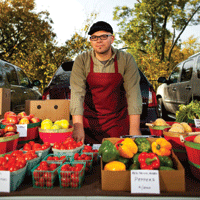GFS’s commitment to local food continues one year after a grant from Toronto’s Greenbelt Fund
In 2006, the team at Gordon Food Service (GFS) began to notice a shift in the industry, as more clients asked for food sourced from local producers. To better understand the changing dynamic, the Milton, Ont.-based company defined the term ‘local Ontario,’ while working with the Ontario Ministry of Agriculture, Food and Rural Affairs. Then the hunt began, and soon GFS had tracked down 300 local products. “At the time we had the opportunity to apply for a Greenbelt grant, so we did, and we were awarded the single largest grant for a foodservice company in Ontario,” recalls Cindy Palmer, sales support specialist, Local Team at GFS. Today, the number of locally sourced products has grown almost three-fold to more than 800.
According to Franco Naccarato, program manager at the Toronto-based Greenbelt Fund, applicants for the grant are measured on their ability to contribute to the Greenbelt’s Broader Public Sector Investment Fund objectives. Namely, it’s determining if the candidate company can drive innovation, provide a favourable ROI, make systemic changes in moving Ontario food from farm to fork and provide solid leadership. It’s also important the recipient is transparent and willing to share the project’s results.
“GFS delivered on all fronts,” says Naccarato. “It was innovative for a distributor to assemble a local-food team, encompassing procurement and sales together. Selling to more than 8,000 customers, we knew they could deliver on economic impact, and they have already demonstrated almost five times their investment in increased purchases of local products,” says Naccarato.
The government grant of $360,000, to be used over a two-year period, has allowed GFS to “work with the Greenbelt Fund closely to help promote local product in the broader public sector,” says Palmer. “A lot of our customers come from that sector — schools, institutions, universities, hospitals — and those customers of ours have been working to increase the amount of local Ontario food they bring into their operations.” Hospitals in Ontario serve approximately 155-million meals a year. If those meals were made with Ontario produce and protein, the benefits to the industry, the economy — not to mention an individual’s health — would be substantial. Palmer says GFS has been helping Greenbelt inch toward that goal by bringing in as much product as possible from local sources.
The grant, disbursed on a quarterly basis, allows GFS to employ a series of internal processes to create a model for others to follow, changing the way foodservice distributors purchase and market local food. “We’ve well exceeded our goal and hope our work to procure, market and sell local-food products will continue to take flight,” says Kelly Anderson, category lead, Bev-erage and Chemical sales specialist, Local Products, GFS Ontario. Already on the ascent is the company’s new ‘Ontario’s Own’ label. The first item on the private, local-food label is an Ontario lasagna. Palmer explains: “everything in that lasagna is now from local sources, which is really exciting for us. And the vendors are realizing there’s an opportunity for them to develop new products based around the local definitions. There’s a market for local product. The customer wins, the vendor wins, but also the producers of the raw ingredients win as well.”
Additionally, in November GFS Ontario changed from using imported apples to initiating an exclusively local-Ontario program. “We estimate this will represent approximately $500,000 in purchases by GFS Ontario from Martin’s Family Fruit farm in Waterloo, Ont., over the course of 2012,” says Palmer.
And, this is only the beginning. “[We hope] to achieve seven per cent sales growth over the next five years,” says Anderson. “Relative to the funding, that growth will be drawn from the broader public sector for the most part.” By 2013, GFS expects to exceed a target of $2 million in new local-food purchases, the bulk of which will come from the dairy category with fresh produce, frozen products and protein.
Anderson feels GFS is ahead of the demand for local Ontario products. “We’re working with a vast array of vendors from all categories who have local products. At this stage, we require customers who’ll create the demand,” she says. “We’d like to see the broader public sector embrace the local initiative by setting minimum standards for a percentage of local product purchases annually.”
The changes the food distribution giant initiated resulted in more than $23 million in sales of Ontario product, an increase of nearly $1.6 million year over year. In 2011, GFS realized growth of 4.1 per cent.
“GFS created a special team to execute its local-food strategy, and after less than a year it is now about to offer the broader public sector hundreds of food-safe products that are traceable and within budget,” says Julienne Spence, acting communications director, The Friends of the Greenbelt Foundation. It’s a strategy that included identifying the needs of customers and the requirements of vendors, which is part of GFS’s ‘Good For You’ sustainability platform.
The grant has attracted the attention of new potential vendors, growers and producers. “They’re coming to us and letting us know what they have from local sources,” Palmer says. “Even cheese vendors have come to us, and they tell us ‘we can now call it local based on your definitions of local.’”
Palmer believes the grant benefits the foodservice industry. “Customers are now able to see in black and white, local products that we have for sale, 100 per cent of the year. Right in our system, in the local connotation directly on their invoice, item by item,” she says.
Moving forward, grantees attend quarterly meetings to network and share their wisdom on sourcing local food. “We have them submit quarterly reports to update us on their project, identifying any potential roadblocks,” says Naccarato. “We follow up with phone calls and one-on-one meetings to help them work through their challenges.”
Meanwhile, GFS’s new strategy is on target. “At GFS we believe local is a category on its own, and it’s here to stay,” says Palmer. “Local procurement, marketing, sales of specifically local Ontario product — it’ll only get bigger and better.”
Keep Reading
Farm to Fork: He Said/She Said
Farm to Fork: Highlighting the Harvest
Farm to Fork: Reinventing the Cheese Wheel
Open for Business: Latest Foodservice Must-Haves





















